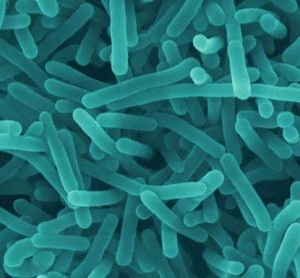Listeria monocytogenes is one specific genus and species pair of bacteria. There are five additional species within the Listeria genus, but only one of these, L. ivanovii, in addition to L. monocytogenes, is considered to be a pathogen, or capable of causing disease. L. ivanovii is not nearly as common an infection however and it is nowhere near as great a concern as L. monocytogenes, which is an organism of great public health concern as it often occurs in large scale outbreaks, sometimes spanning multiple states, due to its association with contaminated fresh and processed food. Because most all references to Listeria are linked specifically to L. monocytogenes, from this point forward this specific organism will be referred to by the shorthand of Listeria.
Listeria Infection
Listeria is not a normal part of the human microbial flora and is always a pathogen. However, in the majority of cases, it causes either no symptoms or only mild flu-like symptoms that resolve on their own. However, for people with immune systems weakened by disease, age, or due to therapeutic medications, and in some otherwise healthy people, Listeria can cause very severe infections of the central nervous system, leading to death in about 25% of cases, and among those who survive there may be lifelong consequences to neurological function. The infection can also be incredibly damaging in pregnant women. Infected mothers commonly experience uterine infection that transmits to the fetus, resulting in spontaneous abortion, stillbirth, or the live birth of a critically ill neonate. Listeria is not an infection to be taken lightly and is definitely one that it is preferable to avoid if at all possible.
Symptoms of Listeria Infection
It can take up to two MONTHS following infection with Listeria to develop symptoms, which almost always include fever and muscle aches, sometimes preceded by diarrhea and/or other gastrointestinal symptoms such as nausea and vomiting. Symptoms may be limited to fever and muscle aches in pregnant women, but this should still be medically evaluated due to the severe risk to the fetus in the event of a Listeria infection. As the infection progresses, people may experience headache, stiff neck, confusion, loss of balance, and even convulsions as the fever and muscle aches continue. It cannot be stressed enough that ANYONE EXPERIENCING THESE SYMPTOMS MUST SEEK MEDICAL CARE IMMEDIATELY! Even if the cause of these symptoms proves not to be Listeria, these types of symptoms often are indicative of central nervous system infections that are frequently fatal, or which cause life-long disability if left untreated! It is almost always better to err on the side of caution when confronting unusual or new medical symptoms. The absence of these symptoms doesn’t rule out Listeria infection, but infection without symptoms is rarely, if ever, a serious condition.
Sources of Listeria Infection
Unfortunately, Listeria is wide-spread in the environment which makes it easy for food stuffs to become contaminated despite the best efforts of commercial preparers. In the last four years, from 2011 to 2014, there have been major reported outbreaks of Listeria in the United States. Three of these outbreaks have been linked to soft cheeses, which are frequently made from unpasteurized milk, although notably one was linked to whole cantaloupe from Colorado. These are certainly not the only outbreaks that have occurred but it is important to note that these outbreaks cannot be considered rare events and annually about 1,600 illnesses are diagnosed with about 260 deaths occurring. Most commonly Listeria contamination is linked to commercially prepared foods such as hot dogs, other preserved meats and sausages, smoked seafood, unpasteurized milk and foods made from it, as well as uncooked fruits and vegetables including, to date, cabbage and cantaloupe. Conceivably, any fresh food could be contaminated given the widespread environmental nature of Listeria. Prepared foods can harbor the infection because Listeria can survive much higher concentrations of salt than most bacteria can, and since Listeria can grow quite readily at refrigerator temperatures as low as 4˚C or about 40˚F, even properly stored foods can remain contaminated and infectious. Contaminated foods do not necessarily look, taste, or smell different from safe foods so there is no certain way to know if foods are contaminated.
Preventing Listeria Infection
One of the important ways to limit exposure to Listeria, aside from thoroughly cooking or reheating potentially infected foods and avoiding unpasteurized dairy products, especially if eaten by those at the highest risk, is to maintain a clean kitchen, or other food preparation, environment. All foods, even those to be eaten peeled should be thoroughly washed, and any surfaces used to prepare or process foods such as lunch meats, hot dogs, cooked sausages, vegetables, and fruit should also be thoroughly washed and sanitized, preferably with a cleaner that is EPA certified and documented to be effective against Listeria. The risk from foods such as melons can be reduced if they are first scrubbed with water and a vegetable brush prior to cooking, but it is then important to ensure that such brushes are sanitized before and after use to avoid spreading the contamination from one item to the next. Also, refrigerators should be thoroughly sanitized, again preferably with an EPA certified and documented agent proven to be effective against Listeria and other food-borne contaminants, especially following any spills of the juices in hot dog packages or direct contact with potentially infected meats, fruits, or vegetables to guard against the transfer of contaminants from one food item to many others that might not have originally been a source of infection. These steps are vital since there is, to date, no vaccine or other preventive measure to guard against Listeria infection, especially among those most vulnerable to infection, including expectant mothers.


